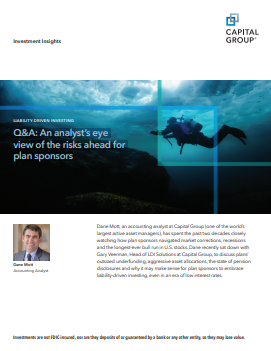In observance of the Christmas Day federal holiday, the New York Stock Exchange and Capital Group’s U.S. offices will close early on Tuesday, December 24 and will be closed on Wednesday, December 25. On December 24, the New York Stock Exchange (NYSE) will close at 1 p.m. (ET) and our service centers will close at 2 p.m. (ET)
Next steps in pension risk management
Capital Group accounting analyst Dane Mott has spent more than two decades assessing corporate pensions. He recently sat down with Gary Veerman, head of LDI solutions, to discuss key pension risk management issues that plan sponsors are facing today. In the third video of a three-part series, Dane and Gary discuss how changes in U.S. accounting rules have limited companies’ ability to inflate operating earnings through pension smoothing mechanisms, and how this has improved the clarity of companies’ financial statements.
Changes in pension accounting
Next steps in pension risk management
Interest rates are low and Pension Benefit Guaranty Corporation premiums are rising. How can plan sponsors manage risk in this environment? When can it make sense to issue debt to fund a pension contribution?
Pension contribution rules have loosened since the Great Financial Crisis. But that can reverse with shifts in the political winds. How do we view companies’ pension contribution policies and aggressive asset allocations in light of this risk?
Gary Veerman: Hi, everyone. My name is Gary Veerman, and I lead the LDI solutions business at Capital Group. I’m joined today by my friend and colleague, Dane Mott. Dane works closely with our investors. His expertise is helping them dig deeper into the accounting of companies that we ultimately invest in. And pensions in particular are one of the areas of Dane’s expertise. And today, we’d like you to better understand ultimately how we look at those companies’ pensions when making investment decisions for our clients. Dane, great to have you with us today.
Dane Mott: Hey Gary, it’s great to be with you.
Gary Veerman: It’s hard to have a pension risk management conversation, Dane, without discussing expected rate of return on assets. Can you give us some perspective on expected return on assets and the way you interpret it as it relates to the earnings of a company?
Dane Mott: Thanks, Gary. That’s an excellent question. Historically, expected return was one of a number of pension smoothing mechanisms built into U.S. GAAP accounting that allowed companies the opportunity to essentially inflate their operating income. That all changed in 2017 with the new accounting standard that resulted in all of the pension effects, other than service cost, getting pushed outside of operating income. So, the implication now is that, from my perspective, service cost is a true business cost and it should be an operating cost. And the others are not necessarily kind of in that realm. And now having them relegated into a single line item below operating income gives analysts and portfolio managers a lot more clarity. It isolates those pension effects, those smoothing mechanisms, into one place, and then the operating income number is something that’s more akin to a company’s economic reality and how a business is truly doing.
Dane Mott: So, if a management team was motivated to have a higher expected return for an income statement benefit, I think that this accounting change kind of mitigates some of those intentions. And hopefully that makes it an easier decision for a management team to really just make their asset allocation decisions based off of what appear to be the right decisions for the plan, for the retirees and for the company, more so than manufacturing a low-quality earnings effect.
Gary Veerman: Just to finish off with an open-ended question, are there any other significant themes in pensions you think are important to highlight?
Dane Mott: One, I guess I would call a trend that we’ve seen over the past decade that I really like to see is there are a lot of companies that are, on their own, adopting mark-to-market accounting for the pensions. It started out with a few brave companies figuring out an approach to basically unwind all those smoothing mechanisms so those non-economic gains and losses wouldn’t be coming through their earnings. And we’ve seen dozens of companies move to that over the past, pretty much the past decade.
Dane Mott: And it’s great because what it results in is that the income statement and the balance sheet of companies are now telling the same story. If your underfunding status improves or gets worse over the course of the year on your balance sheet, your income statement, now with mark-to-market accounting, tells that story rather transparently. Whereas if companies are still using all the smoothing mechanisms, there can be a lot of misleading gains and losses that go through the earnings, and you always end up having to do a lot of work to kind of back out all that smoothing to really see the economic reality.
Dane Mott: So that has pleased me. And you know, especially for companies that do choose to do de-risking, and things like LDI, mark-to-market accounting can lead to some interesting effects, because ultimately, if your assets and liabilities are kind of moving in lockstep with a de-risking strategy, then a lot of those gains and losses will be mitigated. So, it should create an opportunity for your income statement to be just a more reflection of your true operating business, and it helps the investors focus on the part of the business that they want to focus on. They can focus on the business that the management team is engaged in, and have financial results that depict that reality.
Gary Veerman: So Dane, I can’t thank you enough for your comments today, and spending the time here. What’s really apparent is, you know, while we face off with companies from different angles, you more from the company management perspective, me more from the investment perspective, we're having the same conversations, and we’re really driving client decision-making based on a lot of those underlying themes that we touched on. So again, it’s been fun. Hope we get to do it again.
Dane Mott: Thanks, Gary. I’ve enjoyed it.

Dane Mott is a global accounting analyst with 22 years of experience. Prior to joining Capital Group in 2015, Dane was an accounting analyst at his own firm, Dane Mott Research LLC, and at J.P. Morgan and Bear Stearns. He holds an MBA and a bachelor’s degree from New York University. Dane is a CFA charterholder and a certified public accountant.

Gary Veerman is head of LDI solutions at Capital Group. He has 21 years of industry experience and has been with Capital Group for four years. Prior to joining Capital, Gary was managing director and head of U.S. LDI solutions at BlackRock and head of LDI strategy at Legal and General Investment Management America. Before that, he was director of asset allocation research at Rocaton Investment Advisors. He holds a master's degree in global financial analysis from Bentley University and a bachelor's degree in business administration with a concentration in finance from West Virginia University.
Years of experience as of December 31, 2021

An analyst’s eye view of the risks ahead for plan sponsors
Accounting analyst Dane Mott explores pension funding, aggressive asset allocations, and why it may make sense for plan sponsors to embrace liability-driven investing, even in an era of low interest rates.
Connect with our liability-driven investing team.
Our dedicated LDI Solutions Team has experience in pension plan risk management across assets and liabilities and can help address your plan’s unique needs.